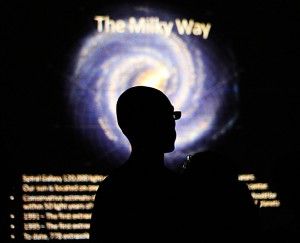Stargazers gather atop Neckers roof

August 26, 2012
From the star cluster Vega to the moon’s deep craters, students, staff and Carbondale residents alike will have the chance to gaze upon these astronomical wonders throughout the fall semester.
Attendees gathered on Neckers’ roof Sunday to view the stars and learn about the solar system with the help of SIU’s physics department. Bob Baer, host of the viewings and computer/electronics specialist, said he started the rooftop observations about two years ago after the building’s roof got an upgrade and community members showed interest in the free event.
Baer said the viewing brought many curious people to the roof in the summer, but the amount of amateur astronomers at the event should almost double with students back in town.
Advertisement
The summer session proved difficult at times because of cloudy days, Baer said, but some notable sightings included Saturn, Mars and the Venus transit, where Venus passes in front of the sun.
However, Baer said fall observations tend to be clearer because cloud cover is limited during that time of the year.
“You can see deep-sky objects much better,” Baer said. “Jupiter will be up in late October and you can see that in the early evening, and let me tell you it’s spectacular. It’s the most interesting of the large planets you can see.”
Sunday was an event to welcome back students and had about 50 people in attendance. Neckers’ observation deck was nearly filled, which Baer said is normal for the popular event during fall and spring semesters.
There will be five viewings in the fall session, three of which will be viewings where something out of the ordinary will happen, Baer said. The first session, scheduled Sept. 19, is a solar observation where a new and improved telescope will get its first use.
Four telescopes were on top of the roof all fixed on different space locations with professors and lecturers explaining what each telescope was displaying.
Advertisement*
A projector also displayed information about the moon and other stars on part of the building.
Baer said he displays fun facts to give patrons a little extra information what they’re seeing through the high-powered telescopes.
April Hendley, a physics lecturer, said even though she has seen most of these objects numerous times before, she still gets excited every time she looks at a planet through a telescope lens.
“Even though I’ve seen Saturn so many times and Jupiter so many times, I still don’t get tired of it,” Hendley said.
Kamden Summers, a lecturer in the Center for English as a Second Language, said she uses the sessions as a final class for upper level English language learners. She said she uses it as a fun way to teach students advanced vocabulary through the topic of astronomy.
The use of astronomy to teach students English is effective because of the interest most people show in the topic, Summers said.
“Everybody can relate to astronomy no matter where you’re from because we all live on the earth, so even though we’re from different countries it brings us together in the classroom,” Summers said.
Le Gao, a graduate student in computer science from Shen Yang, China, said some of the objects she saw interested her, and she will come to more of the observations in the fall.
Andy Edelen, president of the Astronomical Association of Southern Illinois, said his astronomy club and the SIUC physics group crossed paths in June, and the two groups have been able to occasionally combine their efforts to bring in a large number of people.
Edelen said the level of expertise in astronomical observations varies from week to week, which makes for a nice mix of seasoned veterans and amateurs who can share their knowledge and have thoughtful discussions about space.
Now that the two groups collaborate, Edelen said it gives him a chance to get students who are interested in the subject to join the club and experience observations on a more frequent basis.
He said he rarely gets the opportunity to recruit, though, because of the amount of people he gets to talk to at his telescope.
“I actually brought fliers for the astronomy club, but I’ve been more interested in showing people stuff in the telescope than handing out fliers and talking up the club,” he said.
Astronomy observations really take people’s breaths away, he said, and he never gets tired of watching their amazement each week.
Edelen said he is still amazed by the viewings despite his years of experience.
“Sitting at the eyepiece of a telescope at a dark site on a clear night is almost like a religious experience,” Edelen said. “Hunting for galaxies and star clusters … there’s nothing quite like looking at an object that three or four other people have ever observed.”
The observations will take place September 19 3:30-5:30 p.m., September 29 from 8:30-1030 p.m., October 26 from 9 p.m.-midnight, November 25 from 7 p.m.-10p.m. and December 21 from 6:30 to 8:30 p.m
Advertisement








